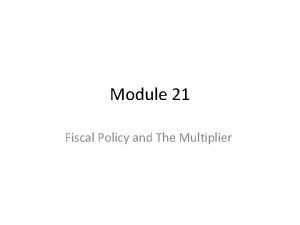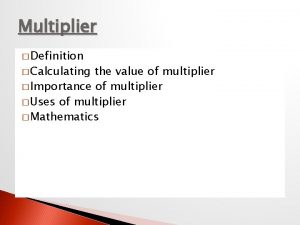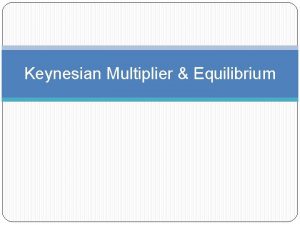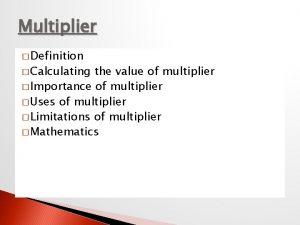Chapter 11 The Output Multiplier Online Texts com














- Slides: 14

Chapter 11 The Output Multiplier © Online. Texts. com p. 1

The multiplier effect • When an autonomous component of Aggregate Demand changes, equilibrium output (Y) will change. • The change in output will be even larger than the initial change in Aggregate Demand. • This result for the change in Y to be greater than the initial change in Aggregate Demand is known as the multiplier effect. © Online. Texts. com p. 2

Calculating the Size of the Multiplier Effect • The size of the multiplier effect is given by: where the (simple) output multiplier is defined as 1/(1 -MPC). © Online. Texts. com p. 3

The simple output multiplier • The simple output multiplier assumes – there are no proportional taxes – all expenditures are for domestically produced goods and services – the price level is fixed © Online. Texts. com p. 4

How and Why the Multiplier Works • When Aggregate Demand rises, output and hence income rise. • The rise in income allows people to consume more goods and services. • This is called "income-induced" consumption and it raises Aggregate Demand even more. © Online. Texts. com p. 5

Example: University builds a new residence hall worth $100 million. MPC=0. 8 © Online. Texts. com p. 6

The Output Multiplier with Proportional Taxes • A proportional tax is a tax that varies with the level of income (e. g. income tax). – If income is taxed at a 20 percent rate, then t = 0. 20. • The formula for the output multiplier when proportional taxes are present, is: © Online. Texts. com p. 7

Proportional taxes reduce the size of the multiplier effect. © Online. Texts. com p. 8

The Output Multiplier with Imports • When income rises, demand foreign goods and services also rises, lowering the demand for U. S. goods & services and dampening the multiplier effect. • The marginal propensity to import (MPI) is the change in imports divided by the change in disposable income. • The output multiplier without proportional taxes but accounting for imports is: © Online. Texts. com p. 9

The Output Multiplier with Price Level Change • For this slide only, we relax the assumption that the price level is fixed. • When the AD curve shifts and the AS curve is upward sloping, the multiplier effect is smaller. • The economy moves from point A to point C, instead of point B. © Online. Texts. com p. 10

The Multiplier Effect and a Temporary Change in Aggregate Demand • If the change in Aggregate Demand is temporary, then the change in output is temporary. • Examples include road or building repairs. © Online. Texts. com p. 11

The Multiplier Effect and a Temporary Change in Aggregate Demand • Equilibrium output rises initially, but the impact dampens out over time. © Online. Texts. com p. 12

The Multiplier Effect and a Permanent Change in Aggregate Demand • If the change in Aggregate Demand is permanent, the equilibrium level of output in the economy is permanently higher. • Examples: new school or prison. © Online. Texts. com p. 13

The Multiplier Effect and a Permanent Change in Aggregate Demand • The overall equilibrium level of output in the economy rises by the initial change in AD times the size of the output multiplier. © Online. Texts. com p. 14
 Bài thơ mẹ đi làm từ sáng sớm
Bài thơ mẹ đi làm từ sáng sớm Cơm
Cơm Hát kết hợp bộ gõ cơ thể
Hát kết hợp bộ gõ cơ thể Slidetodoc
Slidetodoc Bổ thể
Bổ thể Tỉ lệ cơ thể trẻ em
Tỉ lệ cơ thể trẻ em Voi kéo gỗ như thế nào
Voi kéo gỗ như thế nào Tư thế worms-breton
Tư thế worms-breton Chúa yêu trần thế alleluia
Chúa yêu trần thế alleluia Kể tên các môn thể thao
Kể tên các môn thể thao Thế nào là hệ số cao nhất
Thế nào là hệ số cao nhất Các châu lục và đại dương trên thế giới
Các châu lục và đại dương trên thế giới Công thức tiính động năng
Công thức tiính động năng Trời xanh đây là của chúng ta thể thơ
Trời xanh đây là của chúng ta thể thơ Mật thư anh em như thể tay chân
Mật thư anh em như thể tay chân



























